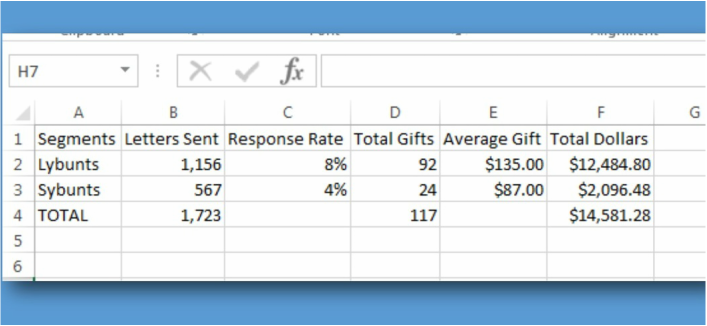|
“Predictive Modeling” sounds intimidating, right? It sounds technical and complicated. You probably think you should hire a consultant to help you create a predictive model for your organization.
Well, let’s all agree together to take the bite out of this phrase. I like Wikipedia’s uncomplicated definition of predictive modeling as a system that “uses statistics to predict outcomes”. Creating a predictive model is merely using statistical educated guesses to build projections and then work with those projections dynamically throughout the year. Projections is a version (model) of what you think will happen in your program this year (predictive). I’ll discuss here how to build you’re your projections and next week, I’ll post about how to work with your model dynamically throughout the year as the actual results impact your ability (for good or for ill) to reach the projected goal. For this exercise, you will need:
You’ll building each segment into your spreadsheet like you’re building a house: brick by brick, cell by cell. This takes a long time but it is the essence of predictive modeling. It must be detailed to be relevant. Once done, you’ll have a powerful tool for the entire year. So, let’s take an example or two (see the chart above): Let’s say you want to know how your fall direct mail will likely perform. You estimate from past results and database reports that you have 1,156 lybunts (last year's donors) and 567 sybunts (donors who gave 3-5 years ago) to send a letter to this fall. Looking at past years, you see that your response rate has been between 8-10% for lybunts and 4-7% for sybunts. You feel like playing it safe so you put in the low-end values. Using formulas (see my video on that topic here), the information you have put in so far tells you that you can expect 92 gifts from the lybunts and 24 from the sybunts. Based on past reports and your best guesses, you put in $135 for a lybunt average gift and $87 for sybunts. This makes your likely total dollars $12,484 from the lybunts and $2,096 from the sybunts. Now, assuming those were your only two segments for fall direct mail, you can then total up the letters, gifts and dollars and you know what to expect. Your models might include just one vehicle (direct mail, phonathon, email solicitations, etc.) or it might include everything your shop plans to bring in. Your model might have hundreds of segments or be exceedingly simple. The point is not to be baroque but specific enough to be valid predictions of results. This method is powerful because you’ll be able to see immediately which segments have a negative return on investment and can decide actively whether they merit sending the letters anyway to acquire the donors. You will also know exactly where you fall short if results don’t live up to these expectations, which enables you to course correct in future projections and change strategy for the rest of the year. I’ll show you how to do this in next Wednesday’s post – “Demystifying Predictive Modeling, Part 2”. Don't ever be intimidated about predictive modeling again. In fact, because of your knowledge of your program, you are the best person to build and adapt your predictive models. You can do this! Comments are closed.
|
Jessica Cloud, CFREI've been called the Tasmanian Devil of fundraising and I'm here to talk shop with you. Archives
June 2024
Categories
All
|


 RSS Feed
RSS Feed
